Headlines and events archive
Displaying 551 - 600 of 1931
You may also find an archive of news published in the media which are related with the Instituto de Astrofísica de Andalucía - CSIC.
Pages

|
04/02/2020 - 12:30
Cosmic butterflies: the product of tempestuous stellar marriages Planetary nebulae are some of the most strikingly beautiful astrophysical phenomena known, gracing many a glossy-paged, coffee-table book and earning them the nickname "cosmic butterflies". Classical stellar evolutionary theory states that all intermediate mass stars should produce a planetary nebula, forming as the star leaves the Asymptotic Giant Branch and evolves towards the white dwarf phase. While it remains the standard for astronomy... Dr. David Jones |
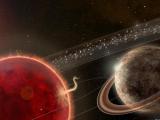
|
15/01/2020
Indications of the existence of a second planet around Proxima Centauri, the closest star to the Sun With a minimum mass of about six times that of the Earth, the planet would revolve around the star at 1.5 times the distance between the Earth and the Sun. This study adds to previous work that points to the existence of a complex planetary system around Proxima Centauri |

|
30/07/2020 - 12:30
SO Webloquio:The Orion Radio All-Stars: new insights into YSO radio emission, using the VLA, VLBA, and ALMA With significant new observing capabilities, centimeter-wavelength radio astronomy is currently in a renaissance leading up to the advent of the Square Kilometre Array (SKA), highlighting new opportunities and also technical challenges. The sensitivity upgrades of both the NRAO Very Large Array (VLA) and the Very Long Baseline Array (VLBA) have begun to provide us with a much improved perspective on stellar centimeter radio emission,... Jan Forbrich |

|
19/03/2020 - 12:30
Study on astrophysical masers in the era of SKA/SKA-VLBI In my colloquium talk, out of the introduction topics mentioned above, I will focus my talk on trigonometry of maser sources yielded with the Square Kilometre Array (SKA) Phase 1. This is one of the science cases that have been planned as Japanese scientific contributions to SKA1. Its key issue is the scientific and technical feasibility in the low frequency band, corresponding to SKA1-MID Band 2 around 1.6 GHz, in which atmospheric effects on... Dr. Prof Hiroshi Imai |

|
31/01/2020 - 12:30
NoiseChisel and Gnuastro: non-parametric detection and analysis of astronomical targets Astronomical instrumentation has greatly advanced over the last 40 years: with digital detectors, space telescopes and +8m class ground-based telescopes for example. However, the signal-based detection paradigm (for example from Petrosian or Kron in the 1970s, mostly used as implemented in SExtractor from the mid-1990s) is still the dominant method of low-level data analysis: detection, segmentation and measurements or catalog production. In... Dr. Mohammad Akhlagh |

|
09/01/2020 - 12:30
Galaxy evolution and weak lensing studies in the J-PAS survey During the next year, the J-PAS survey will start imaging the northern sky with a unique photometric system composed of 56 narrow and 4 broad bands. The peculiar configuration and strategy of this survey pursue to provide accurate low-resolution spectra or photo-spectra (FWHM~125 \AA) allowing us to obtain high-quality photometric redshifts (\sigma_z~0.003 for LRGs) for millions of galaxies across 8000 deg^2 of the sky. Recently, the J-PAS... Dr. Luis Díaz García |
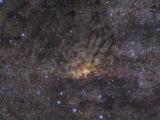
|
16/12/2019
IAA researchers discover an extremely violent episode in the history of the Milky Way, with over a hundred thousand supernova explosions A survey with an unprecedented resolution of the central regions of our galaxy reveals its full history of star formation, which presents steep ups and downs in star formation. There are indications of a burst of star formation so intense that it caused more than one hundred thousand supernova explosions |

|
27/02/2020 - 12:30
Proper motion study of the Galactic Centre Stellar proper motion studies in the centre of the Milky Way have been typically limited to the Quintuplet, Arches, and central parsec clusters. In this talk, I will present the primary results of a large-scale proper motion study of the central ~ 36' x16' of the Galaxy based on our GALACTICNUCLEUS survey (epoch 2015) combined with the HST Paschen-alpha survey (epoch 2008). This region of our Galaxy is not covered sufficiently by the existing... Dr. Banafsheh Shahzamanian |
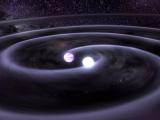
|
10/12/2019
Astronomers observe the approach of the stars of a binary system due to the emission of gravitational waves The system is composed of two white dwarf stars that revolve around the common centre of mass every twenty minutes, and which are gradually approaching. The work, in which the Institute of Astrophysics of Andalusia (IAA-CSIC) participates, shows that the stars have “flattened out” and have an ellipsoidal shape due to the tidal forces |

|
19/12/2019 - 12:30
The SKA precursor telecope MeerKAT as a galaxy evolution explorer MeerKAT is a radio telescope situated in South Africa's Karoo desert. It has recently been built as an SKA demonstrator and precursor telescope and was inaugurated in August 2018. Since then it has proven to be the world's most sensitive 20cm interferometer and is slowly moving towards standard operation. Thanks to its array layout MeerKAT is a superb telescope to observe in particular the HI line, hence tracing the most abundant atom in its... Dr. Józsa Gyula István Géza |
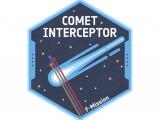
|
26/06/2019
The Institute of Astrophysics of Andalusia (IAA-CSIC) participates in Comet Interceptor, ESA's new mission to study a pristine comet IAA collaborates in the development of four of the nine instruments on board the mission |

|
05/03/2020 - 12:30
Round Table: Dia de la Mujer To be provided Round Table |

|
02/12/2019
Astronomers find a star that hides, among its pulsations, flares millions of times more intense than those of the Sun Observations with the Kepler satellite allow surface activity to be found in stars where, according to theoretical models, it should not occur. In the sample highlights the star KIC 9716385, which presents, hidden between its pulsations, flares millions of times more intense than the solar ones |

|
30/01/2020 - 12:30
Mirror-slicer Array for Astronomical Transients. A new Integral Field Spectroscopy mode for OSIRIS at GTC MAAT (Mirror-slicer Array for Astronomical Transients) is proposed as a new mirror-slicer optical system that will allow the OSIRIS spectrograph at the 10.4 m GTC the capability to perform integral-field spectroscopy (IFS) over a seeing-limited field of view 14.20’' x 10'' with a slice width of 0.303''. MAAT will enhance the resolution power of OSIRIS by 1.6 times with respect to its 0.6'' wide long-slit. All the eleven OSIRIS grisms and VPHs... Dr. Francisco Prada |

|
05/12/2019 - 12:30
Gaia mapping mission and science of Solar System Objects I will present the generalities of the Gaia surveying mission, and current status. I will then discuss the improvement brought by Gaia over its 5 years and more of mission—starting with DR1—for the science of asteroids and other SSOs; and focusing especially on the astrometry and dynamics of asteroids. After reminding generalities on SSO observations by Gaia - and some of their peculiarities, we present some of the advances obtained from the... Dr. Daniel Hestroffer |

|
10/12/2019 - 12:30
SO-IAA Colloquium: Unveiling the nature of planetary systems The burgeoning field of exoplanets has yielded thousands of discoveries, which collectively have the potential to help us better understand our place in the Universe. Every month more and more planetary systems are being discovered,some of them in highly exotic configurations never observed previously. The combination of different techniques and studies are needed to unveil the real nature of these planetary systems. In this seminar, I will... Dr. Francisco Pozuelos |
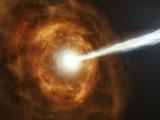
|
20/11/2019
Collapsing star breaks the records in very high energy photons production MAGIC telescopes, on the island of La Palma, detect photons in the range of teraelectronvolts in a gamma ray explosion (GRB), the product of the death of a very massive star. The detection, which requires contemplating new mechanisms in the energy production of GRBs, provides a fundamental perspective to complete our understanding of these events |
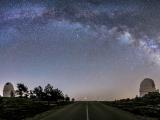
|
20/11/2019
Public Surveys and new instrumentation for Calar Alto Observatory Calar Alto Observatory opens a call for new instrumentation projects |

|
13/02/2020 - 12:30
From protostars to planets: the astrochemical link Protostars accrete their material from the natal cloud through accretion disks. These disks are progressively dispersed by the recently formed star to form protoplanetary discs in which planets are born. Although this process takes a few million years, now we think that the final chemical composition of the gas and dust in the proto-planetary disk is to a large extent determined by the chemical evolution in the natal cloud. Determining the... Dr. Asunción Fuente |

|
07/11/2019
An invisible companion could explain the strong X-ray emission of the Eskimo Nebula. An international group of astronomers led by the Instituto de Astrofísica de Andalucía finds a periodic variation in the X-ray emission of the central star of the Eskimo Nebula. |

|
26/11/2019 - 12:30
Inverse Compton emission revealed by observations up to TeV energies of GRB 190114C The hunt for Gamma-Ray-Bursts (GRBs) at very high energy (VHE) started more than 20 years ago. A hint of emission was already claimed by Milagrito from the observations of GRB 970417. On 19 of January the Major Atmospheric Gamma Imaging Cherenkov (MAGIC) clearly detected GRB 190114C above 0.2 TeV. This is the first highly significant detection (over 50sigma reached in the first few tens of minutes after the burst) of a GRB at VHE. GRB190114C... Dr. Elena Moretti |

|
23/01/2020 - 12:30
SO Colloquia: Extragalactic survey science in the 2020s: the role of radio continuum observations with the SKA Extragalactic surveys in the 2020s will reveal the full diversity of the galaxy assembly process: from environment-dependent evolution to the build-up of mass inside galaxies, and with a complete accounting of all relevant processes/constituents ensured by multi-wavelength coverage. Observations at radio wavelengths carry a unique potential in that they can probe star-formation activity and cold gas content, i.e. place constraints on both galaxy... Mark T. Sargent |

|
15/01/2020 - 12:30
Public Surveys and new instrumentation for Calar Alto Observatory The Calar Alto observatory (CAHA) is a key institution for the international astronomical community, for its highly competitive astronomical facilities (telescopes and instrumentation). From 2019 on, the current administration of CAHA includes the Junta de Andalucía as a new partner – replacing the Max Planck Gesellschaft -, and together with the Spanish National Research Council (CSIC) these two institutions manage the operation of the... Dr. Jesus Aceituno |

|
31/10/2019 - 00:15
Seriously: Is anyone out there? Juan Carlos Suárez |
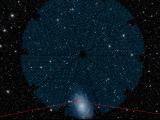
|
28/10/2019
Five thousand "eyes" to capture the colors of the cosmos The Dark Energy Spectroscopic Instrument (DESI) sees first light. DESI, a project with the participation of the IAA-CSIC, will improve the understanding of the role of dark energy in the history of the expansion of the universe |
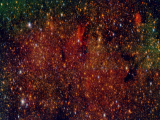
|
14/10/2019
The first results of the GALACTICNUCLEUS project, the most detailed star catalogue of the galactic centre, are published GALACTICNUCLEUS will allow to study the stellar population surrounding the super-massive black hole of the galactic centre with unprecedented detail |

|
06/02/2020 - 12:30
SO Colloquia: Extrasolar planets: recent advances and future challenges Recently a group of scientists has confirmed the presence of water in the atmosphere of a super Earth orbiting in the habitable zone of its host star. But what what does this milestone represent in the search for life outside Earth? What do we mean by habitable? What do we really know about extrasolar planets, their internal structure or origins? What is a super Earth, the most common planet category know to date for which no example is found in... Dr. Juan Cabrera |
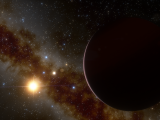
|
06/10/2019
CARMENES finds an anomalous planetary system that challenges our understanding of how planets form CARMENES finds an anomalous planetary system that challenges our understanding of how planets form |
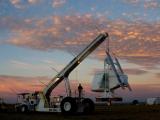
|
06/10/2019
The mirror of the SUNRISE mission, which will study the Sun from a stratospheric balloon, gets ready at Calar Alto The mirror of the SUNRISE mission gets ready at Calar Alto |

|
29/10/2019 - 12:30
Nebular HeII emission from spatially resolved metal-poor star-forming galaxies Nebular HeII1640,4686 emission, observed to be more frequent in high-z galaxies than locally, is indicative of far harder ionizing spectrum than that seen in nearby systems. Star-forming galaxies with lower metal content tend to have a larger nebular HeII intensities compared to those with higher metallicities. This agrees with the expected harder spectral energy distribution at the lower metallicities typical in the early universe. Theoretical... Dra. Carolina Kehrig |

|
04/10/2019 - 12:30
Cúmulos Jóvenes: eclosionando, moviéndose, volando En las últimas dos décadas, nuestro conocimiento de los cúmulos estelares jóvenes, ha progresado rápidamente del uso de imágenes estáticas con cada vez mayor calidad, hacia mapas de movimientos en seis dimensiones (posiciones, velocidades), que están cambiando muchas de nuestras ideas de cómo los cúmulos estelares surgen de los complejos de nubes moleculares. Conforme nos movemos de escalas de parsecs a hectoparsecs, ahora vemos a los cúmulos... Dr. Carlos G. Román Zúñiga |

|
22/10/2019 - 12:30
Data mining Gaia DR2: the quest for Pre-Main Sequence Stars (and their discs) As the birth-sites of planets, protoplanetary discs have become the object of intense study during the last years. Constraining their typical lifetimes, masses and/or sizes is crucial to understand the process of planet formation. These objects are a natural by-product of early stellar evolution, and therefore a high fraction of Pre-Main Sequence Stars (PMS) are surrounded by a protoplanetary disc. The current census of PMS (and discs) has been... Dr. Héctor Cánovas |
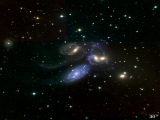
|
19/09/2019
Rediscovering the "Stephan's Quintet" Researchers from the IAA-CSIC has completed a detailed study of the so-called "Stephan's Quintet", a paradigmatic compact system of galaxies. |

|
02/12/2019 - 12:30
Molecular outflows: evolution, structure and angular momentum We present a theoretical model in order to explain the formation and the evolution of the molecular outflows associated to protostars. In this model, we assume that the molecular outflow is a thin shell formed by the interaction between a fast stellar wind and a rotating cloud envelope in gravitational collapse. We obtain a set of partial differential equations, these equations are space and time dependent, and describe the physical properties... Dr. Alejandro López Vázquez |

|
23/10/2019 - 12:30
Molecular spectroscopy at high resolution for everyone Molecular observations at high resolution is being revolutionized by the success of ALMA and the upcoming advent of SKA. In this talk I will explain the recent progress in the field of molecular observations in the central regions of galaxies and the big steps that we are currently making in the use and understanding of molecular tracers as a proxy to buried physical processes in active galaxies. I will show some preliminary results from the... Dr. Sergio Martín Ruiz |

|
19/09/2019 - 12:30
JPAS: A survey for Galaxy Evolution studies JPAS is a survey of 5000-8000 deg2 of the sky with 56 narrow band filters in the Observatory of Javalabre. This survey is very relevant for Cosmology, Galaxy Evolution and Stellar Physics studies. In January 2020, JPAS with its JPCam will have the first light. However, the project has already taken data of 2 deg2 of the sky in two cosmological fields (AEGIS and JWST-NEP). The 2-4th of December will be the first data release (DR1) during the RIA... Dr. Rosa González Delgado |

|
09/09/2019
The Institute of Astrophysics of Andalusia (IAA-CSIC) receives the distinction Center of Excellence Severo Ochoa The official delivery of these distinction to scientific excellence is celebrated in Madrid |
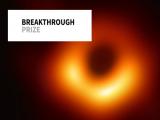
|
06/09/2019
IAA researchers, in the "Oscars of Science" The Breakthrough Prize in Fundamental Physics, endowed with three million dollars, has been awarded to the Event Horizon Telescope (EHT) international collaboration, which obtained the first image of a black hole. Two researchers from the Institute of Astrophysics of Andalusia (IAA-CSIC) participate in the collaboration, which brings together 347 researchers |

|
28/11/2019 - 12:30
SO-IAA Colloquium: Recent advances about the exoplanetary exospheres The upper atmosphere of a planet plays a key role at protecting the lower altitudes from the effects of energetic stellar EUV and soft X-ray photons and keV-energy precipitating particles. Through a variety of transport processes, the upper atmosphere also participates in the net loss of a planet’s bulk composition into space. As such, the physics and chemistry occurring in the upper atmosphere influence the evolution of a planet over its... Antonio García Muñoz |

|
07/11/2019 - 12:30
SO-IAA Colloquium: Characterization of (exo)Planetary Atmospheres Characterization of planetary atmospheres has always been a challenge. While the next generation of facilities, such as ELT, JWST, and ARIEL, will improve our understanding of planetary atmospheres, the number of well-characterized exoplanet atmospheres is expected to remain limited. Large-scale simulations assist us with this shortcoming by predicting the diversity of the planetary atmospheres, connecting the spare observational measurements,... Dr. Karan Molaverdikhani |

|
03/10/2019 - 12:30
Some aspects of high precision machines for astronomical applications Cranfield Precision are not specialists in astronomy but their expertise in designing and building very precise special-purpose machines has contributed to several important astronomical projects. In this talk I will show several machines with astronomical applications and select some features of particular interest for discussion. Richard May-Miller |

|
05/09/2019 - 12:30
Broad line AGN in the MaNGA survey This talk presents a way to find Type I Active Galactic Nuclei in the MaNGA survey (Mapping Nerby Galaxies at Apache point observatory). The method is based on flux ratios between spectral regions where a broad line in emission is expected. Likewise, the spectroscopic analysis of 44 galaxies with nuclear activity is shown; as well as the estimation of the mass of supermassive black holes and the effect that the active nucleus has on... Dra. Alenka Negrete |

|
17/10/2019 - 12:30
SO-IAA Colloquium: What's is the metallicity of cool dwarf stars? Cool dwarfs are the most numerous stars in the Galaxy and they account for most of its baryonic mass. However, they are likely the least understood main sequence stars. Their complex atmospheres, due to their low temperatures and high surface gravities, have made their spectroscopic study a hard task. Until recently, their basic physical properties, such as radii and mass, were poorly constrained due to the lack of empirical data. Stellar... Bárbara Rojas-Ayala |
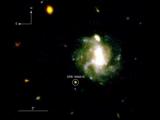
|
27/08/2019
A distant stellar collision with the shine of precious metals A signature similar to the gold and platinum producing explosion observed in light and gravitational waves in 2017 is found in the data of a 2016 gamma ray explosion. This confirms that heavy elements are produced in kilonovas, bursts that result from the fusion of very compact objects, such as neutron stars or black holes |

|
12/09/2019 - 12:30
Detection of Exocomets: The gaseous environment of Main-Sequence Stars Planetesimals and small solid bodies in general are key to understand the chemical and dynamical evolution of planetary systems. Direct detection outside the Solar System is still not feasible. However, indirect evidences of such bodies as dusty debris disks or the presence of large amounts of gas in the close-in surroundings of main-sequence stars have been collected for over 30 years now. Transient events observed as variable non-... Dr. Isabel Rebollido |
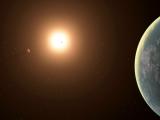
|
31/07/2019
Space and ground-based observations reveal a planetary trio around a nearby star Combining data from the TESS satellite and from various instruments on the ground, CARMENES among others, leads to the detection of a multiple planetary system around a nearby star. The work, which involves researchers from Instituto de Astrofísica de Andalucía (IAA-CSIC), opens the door to the detailed study of multiple planetary systems |

|
10/10/2019 - 12:30
THE INNER DEBRIS OF SN1987A: MOLECULAR AND DUST EMISSION The supernova SN1987A in the Large Magellanic Cloud, together with new instrumentation like ALMA, offers an unprecedented opportunity to tackle fundamental issues of supernova explosions. Large masses of molecules and dust have been formed in its inner debris over the last 25 years. Recently developed tomographic techniques have allowed to obtain 3D-images of its molecular emission. Also, high-resolution images of dust emission have recently... Prof. Jon Marcaide |
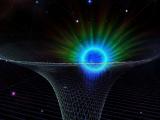
|
25/07/2019
The orbit of a star around the supermassive black hole of the Milky Way confirms the validity of Einstein's theory of relativity The star S2 draws an ellipse around Sagittarius A *, the black hole of the galactic nucleus, and its monitoring over twenty-six years has allowed studying the gravity in extreme environments. Researchers from the Institute of Astrophysics of Andalusia (IAA-CSIC) participate in the results, which are published in the journal Science |
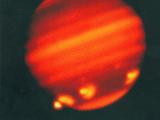
|
17/07/2019
25th anniversary of the impact of the comet Shoemaker-Levy 9 against Jupiter Between July 16 and 24, 1994, comet Shoemaker-Levy 9 hit Jupiter. Every observatory in the world was watching this unique event in history. |

|
12/12/2019 - 12:30
NGC 7469 as seen by MEGARA: new results from high-resolution IFU spectroscopy In this talk I will present highlights from our recent work about the analysis of high-resolution (R ~ 20 000) GTC/MEGARA integral-field unit spectroscopic observations, obtained during the commissioning run, in the inner region (12.5arcsec×11.3arcsec) of the active galaxy NGC7469, at spatial scales of 0.62 arcsec. We explore the kinematics, dynamics, ionisation mechanisms and oxygen abundances of the ionised gas, by modelling the Hα-[NII]... Dr. Sara Cazzoli |